I want to draw three lines for three values on time chart on xy-axis. from this helpful page How to adjust the xand y axis line in jfreecharts I can draw a one line for one value on time chart, so my question is that how can I draw three lines on time chart?
Notice that drawing three line is reduced to drawing a two line, so if you can draw a two-line, then you're able to answer this question, I just want to find the key role here in this code that draws one line in order to add another line.
In one way to do that I tried to put the following this.series.add(new Millisecond(), this.lastValue2);on actionPerformed() and define a new dataset but this doesn't help.
this is the code that is taken from previous link [1].
public class DynamicLineAndTimeSeriesChart extends ApplicationFrame implements ActionListener {
/** The time series data. */
private TimeSeries series;
/** The most recent value added. */
private double lastValue = 100.0;
/** Timer to refresh graph after every 1/4th of a second */
private Timer timer = new Timer((1000), this);//1/4th = 250 ms, to put 1 minute then = 1000*60. 1 second = 1000 ms, 1/4 secon = 250 ms
private double lastValue2 = 1.0;
/**
* Constructs a new dynamic chart application.
*
* @param title the frame title.
*/
public DynamicLineAndTimeSeriesChart(final String title) {
super(title);
this.series = new TimeSeries("Random Data", Millisecond.class);
final TimeSeriesCollection dataset = new TimeSeriesCollection(this.series);
final JFreeChart chart = createChart(dataset, dataset);
timer.setInitialDelay(1000);
//Sets background color of chart
chart.setBackgroundPaint(Color.LIGHT_GRAY);
//Created JPanel to show graph on screen
final JPanel content = new JPanel(new BorderLayout());
//Created Chartpanel for chart area
final ChartPanel chartPanel = new ChartPanel(chart);
//Added chartpanel to main panel
content.add(chartPanel);
//Sets the size of whole window (JPanel)
chartPanel.setPreferredSize(new java.awt.Dimension(800, 500));
//Puts the whole content on a Frame
setContentPane(content);
timer.start();
}
/**
* Creates a sample chart.
*
* @param dataset the dataset.
*
* @return A sample chart.
*/
private JFreeChart createChart(final XYDataset dataset, final XYDataset dataset2)
{
final JFreeChart result = ChartFactory.createTimeSeriesChart("Dynamic Line And TimeSeries Chart",
"Time (every 2 minutes)",
"Value of binary bits",
dataset,
true,
true,
false
);
//
// final JFreeChart result2 = ChartFactory.createTimeSeriesChart("Dynamic Line And TimeSeries Chart",
// "Time (every 2 minutes)",
// "Value of binary bits",
// dataset,
// true,
// true,
// false
// );
//
final XYPlot plot = result.getXYPlot();
// final XYPlot plot2 = result2.getXYPlot();
// plot2.setBackgroundPaint(Color.BLACK);
// plot2.setDomainGridlinesVisible(true);
//
plot.setBackgroundPaint(new Color(0xffffe0));
plot.setDomainGridlinesVisible(true);
plot.setDomainGridlinePaint(Color.lightGray);
plot.setRangeGridlinesVisible(true);
plot.setRangeGridlinePaint(Color.lightGray);
ValueAxis xaxis = plot.getDomainAxis();
xaxis.setAutoRange(true);
//Domain axis would show data of 60 seconds for a time
xaxis.setFixedAutoRange((1*60.0*1000.0)); // 60 seconds = 1 minutes, 60*60.0*1000.0= 1 hour of graph
xaxis.setVerticalTickLabels(true);
ValueAxis yaxis = plot.getRangeAxis();
yaxis.setRange(0.0, 300.0);
// ValueAxis xaxis2 = plot2.getDomainAxis();
// xaxis2.setAutoRange(true);
//
// //Domain axis would show data of 60 seconds for a time
// xaxis2.setFixedAutoRange((1*60.0*1000.0)); // 60 seconds = 1 minutes, 60*60.0*1000.0= 1 hour of graph
// xaxis2.setVerticalTickLabels(true);
ValueAxis yaxis2 = plot.getRangeAxis();
yaxis2.setRange(0.0, 1000.0);
return result;
}
public void actionPerformed(final ActionEvent e) {
final double factor = 0.9 + 0.2*Math.random();
this.lastValue = this.lastValue * factor;
this.lastValue2 = Math.random();
// final Millisecond now = new Millisecond();
this.series.add(new Millisecond(), this.lastValue);
// System.out.println("Current Time in Milliseconds = " + now.toString()+", Current Value : "+this.lastValue);
}
}
